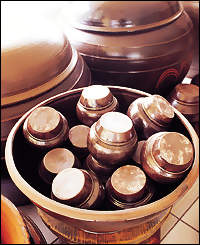|
|
|

Onggi
A Natural Pot Made From Clay
 n Onggi is a Korean traditional pot made of clay throughout Korean
history from ancient times. This special vessel is used specifically to
store Korean traditional food such as kimchi, soy sauce, and soybean
paste. In addition to vessels meant for food storage, there are many
products made of clay, which were used in daily Korean life, such as
chimney pipes, candle sticks, and lamp oil containers. Whenever any of
these items were broken or thrown away they could be disposed of easily
with out causing any pollution of the environment. Onggi is indeed a
most natural vessel.
n Onggi is a Korean traditional pot made of clay throughout Korean
history from ancient times. This special vessel is used specifically to
store Korean traditional food such as kimchi, soy sauce, and soybean
paste. In addition to vessels meant for food storage, there are many
products made of clay, which were used in daily Korean life, such as
chimney pipes, candle sticks, and lamp oil containers. Whenever any of
these items were broken or thrown away they could be disposed of easily
with out causing any pollution of the environment. Onggi is indeed a
most natural vessel.
Onggi's Scientific Design
There are two basic forms of Onggi which differ in the way they are
fired and glazed. Ojigeuleut Onggi is fired at around
1200oC after being covered in a glaze made
from lye. This produces a lustrous shine to these vessels. Gilgeuleut
Onggi is fired at 600oC to
700oC, and does not have a lye glaze.
Korea is a country well known for its ceramics making technology. The
Koryo (935-1392) and Joseon (1392-1910) dynasties produced many kinds of
ceramics. Among them, Cheongia, Bucheongsagi, and Baekja are highly
estimated in the world for their beauty. But these styles were enjoyed
exclusively by the noble class, and are known mostly for their beauty
and artistic value. However, Onggi was, and still is, used by all people
for storing fermented foods because it accelerates the fermentation.
People prefer to store fermented food in Onggi pots because it also
preserves the fermented food well. Onggi vessels are porous and
therefore well ventilated. Onggi can also be used to preserves the
freshness of rice and barley, and to prevent them from decaying.
Onggi Making: A Very Particular Process
Onggi can preserve water as well as food for a long time due to the
special process by which it is made. When making Onggi clay and water
are mixed together and then the shape of the vessel is formed. As it
dries, tiny holes are left due to the evaporation of moisture. A glaze
is then added which fills the holes and the vessel is set in the shade
to dry for three days. Onggi must then be fired in a wood-burning kiln
at very high temperatures. The burning wood produces soot which mixes
with the glaze on the vessels. This combination creates a dark shiny
vessel with excellent ventilation to prevent food from decaying.
Onggi are cherished pots among Koreans as it is regarded as a vessel
which helps to preserve one's health. People can easily purchase Onggi
on the streets near Gyeongbok-gung (located on subway line number 3) as
well as in the stores in Insa-dong (near Anguk station, line number 3).
You can also appreciate the variety of shapes which Onggi are made in
when you visit the folklore museum.
(Sourced from WHAT'S ON SEOUL)
|
|
|
 n Onggi is a Korean traditional pot made of clay throughout Korean
history from ancient times. This special vessel is used specifically to
store Korean traditional food such as kimchi, soy sauce, and soybean
paste. In addition to vessels meant for food storage, there are many
products made of clay, which were used in daily Korean life, such as
chimney pipes, candle sticks, and lamp oil containers. Whenever any of
these items were broken or thrown away they could be disposed of easily
with out causing any pollution of the environment. Onggi is indeed a
most natural vessel.
n Onggi is a Korean traditional pot made of clay throughout Korean
history from ancient times. This special vessel is used specifically to
store Korean traditional food such as kimchi, soy sauce, and soybean
paste. In addition to vessels meant for food storage, there are many
products made of clay, which were used in daily Korean life, such as
chimney pipes, candle sticks, and lamp oil containers. Whenever any of
these items were broken or thrown away they could be disposed of easily
with out causing any pollution of the environment. Onggi is indeed a
most natural vessel.